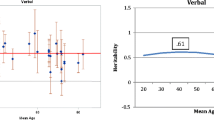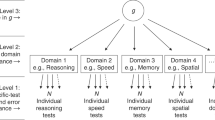Abstract
Processing speed (PS) is one of the basic elements of cognitive functions and has been regarded as a “common mechanism” which mediates general cognitive decline in aging. The present study of Australian twins (117 monozygotic pairs, 98 dizygotic pairs, and 42 single twins aged 65 years and over), estimated the genetic influences in five measures of PS: Digit Symbol Coding (DS), Trail Making Test A (TMTA), Stroop color naming and word reading (Stroop), Simple Reaction Time (SRT) and Complex Reaction Time (CRT); and their covariation with general cognitive ability (GCA): reasoning, problem-solving, and memory. Additive genetic factors explained 62% of the variance in DS, 42% in TMTA, 57% in Stroop, and 48% and 35% in SRT and CRT, respectively. Quantitative genetic modeling showed that all of the covariation between the five PS measures and GCA could be explained by one common genetic factor, while the covariation between the PS measures was partly explained by non-shared environmental as well as genetic influences. The genetic correlation among the PS measures was strongest for DS and TMTA, and between the PS measures and GCA was strongest for DS. These findings suggest that the different PS measures, as well as GCA were to a large extent influenced by the same set of genes and that the relationship between PS and GCA is entirely due to shared-genetic influences.

Similar content being viewed by others
References
Akaike H (1987) Factor analysis and AIC. Psychometrika 52:317–332
Anderson TM, Sachdev PS, Brodaty H, Trollor JT, Andrews G (2007) Effects of sociodemographic and health variables on mini-mental state exam scores in older Australians. Am J Geriatr Psychiatry 15(6):467–476
Australian Bureau of Statistics (ABS) (2009) Population by age and sex, regions of Australia. www.abs.gov.au
Australian Institute of Health and Welfare (AIHW) (2007) Older Australia at a glance, 4th edn. AIHW, Canberra
Baddeley A (1986) Working memory. Claredon Press, Oxford
Barona A, Reynolds C, Chastain R (1984) A demographically based index of premorbid intelligence for the WAIR-R. J Consult Clin Psychol 52(5):885–887
Beaujean AA (2005) Heritability of cognitive abilities as measured by mental chronometric tasks: a meta-analysis. Intelligence 33:187–201
Birren JE, Fisher LM (1995) Aging and speed of behavior: possible consequences for psychological functioning. Annu Rev Psychol 46:329–353
Bleecker ML, Bolla-Wilson K, Agnew J, Meyers DA (1987) Simple visual reaction time: sex and age differences. Dev Neuropsychol 3(2):165–172
Christensen H, Kumar R (2003) Cognitive changes and the aging brain. In: Sachdev PS (ed) The aging brain: the neurobiology and neuropsychiatry of aging. Swets and Zeitlinger BV, Lisse, pp 75–98
Crawford JR, Deary IJ, Starr J, Whalley LJ (2001) The NART as an index of prior intellectual functioning: a retrospective validity study covering a 66-year interval. Psychol Med 31:451–458
Crowe SF, Benedict T, Enrico J, Mancuso N, Matthews C, Wallace J (1999) Cognitive determinants of performance on the digit symbol-coding test, and the symbol search test of the WAIS-III, and the symbol digit modalities test: an analysis in a healthy sample. Aust Psychol 34(3):204–210
Der G, Deary IJ (2006) Age and sex differences in reaction time in adulthood: results from the United Kingdom Health and Lifestyle Survey. Psychol Aging 21(1):62–73
Deary IJ, Johnson W, Starr JM (2010) Are processing speed tasks biomarkers of cognitive aging? Psychol Aging 25(1):219–228
Delis DC, Kaplan E, Kramer JH (2001) Executive function system: examiner’s manual. The Psychological Corporation, San Antonio, pp 91–103
Finkel D, McGue M (1993) The origins of individual differences in memory among the elderly: a behavior genetic analysis. Psychol Aging 8:527–537
Finkel D, McGue M (2007) Genetic and environmental influences on intraindividual variability in reaction time. Exp Aging Res 33:13–35
Finkel D, Pedersen NL (2000) Contribution of age, genes, and environment to perceptual speed and cognitive ability. Psychol Aging 15:56–64
Finkel D, Pedersen NL (2004) Processing speed and longitudinal trajectories of change for cognitive abilities: the Swedish adoption/twin study of aging. Aging Neuropsychol Cogn 11:325–345
Finkel D, Pedersen N, McGue M, McClearn GE (1995a) Heritability of cognitive abilities in adult twins: comparison of Minnesota and Swedish data. Behav Genet 25:425–431
Finkel D, Pedersen N, McGue M (1995b) Genetic influence on memory performance in adulthood: comparison of Minnesota and Swedish Twin Data. Psychol Aging 10(3):437–446
Finkel D, Reynolds CA, McArdle JJ, Hamagami F, Pedersen NL (2009) Genetic variance in processing speed drives variation in aging of spatial and memory abilities. Dev Psychol 45(3):820–834
Folstein MF, Folstein SE, McHugh PR (1975) “Mini-Mental State” a practical method for grading the cognitive state of patients for the clinician. J Psychiatr Res 12:189–198
Ho H, Baler L, Decker SN (1988) Covariation between intelligence and speed of cognitive processing: genetic and environmental influences. Behav Genet 18:247–261
Kelley J, Evans MDR (1996) Trends in educational attainment in Australia. Survey data from the ISSS/A. 28,000 cases. www.international-survey.org/wwa_pub/articcles/hst-ed5.htm
Lessov-Schlaggar CN, Swan GE, Reed T, Wolf PA, Carmelli D (2007) Longitudinal genetic analysis of executive function in elderly men. Neurobiol Aging 28:1759–1768
Lezak MD, Howieson DB, Loring DW (2004) Neuropsychological assessment, 4th edn. Oxford University Press Inc, New York
MacDonald SW, Hultsch DF, Strauss E, Dixon RA (2003) Age-related slowing of digit symbol substitution revisited: what do longitudinal age changes reflect? J Gerontol Psychol Sci 58(B):187–194
Majeres RL (1983) Sex differences in symbol-digit substitution and speeded matching. Intelligence 7:317–327
McClearn GE, Johansson B, Berg S, Pedersen NL, Ahern F, Petrill SA, Plomin R (1997) Substantial genetic influence on cognitive abilities in twins 80 or more years old. Science 276:1560–1563
McGue M, Christensen K (2001) The heritability of cognitive functioning in very old adults: evidence from Danish twins aged 75 years and older. Psychol Aging 16:272–280
McGue M, Christensen K (2002) The heritability of level and rate-of-change in cognitive functioning in Danish twins age 70 years and older. Exp Aging Res 28:435–451
McGue M, Christensen K (2007) Social activity and healthy aging: a study of Danish twins. Twin Res Hum Genet 10:255–265
Neale MC (2005) Twin studies: software and algorithms. Encyclopedia of life sciences. Wiley, New York. www.els.net
Neale MC, Boker SM, Xie G, Maes HH (2002) Mx: statistical modeling. Department of Psychiatry, VCU, Richmond, VA
Nelson HE, Willison JR (1991) National adult reading test (NART): test manual, 2nd edn. NFER-Nelson, Windsor
Neubauer AC, Spinath FM, Riemann R, Angleitner A, Borkenau P (2000) Genetic and environmental influences on two measures of speed of information processing and their relation to psychometric intelligence: evidence from the German observational study of adult twins. Intelligence 28(4):267–289
Pedersen NL, Plomin R, Nesselroade J, McClearn GE (1992) A quantitative genetic analysis of cognitive abilities during the second half of the life span. Psychol Sci 3:346–352
Pedersen NL, Plomin R, McClearn GE (1994) Is there G beyond g? (Is there genetic influence on specific cognitive abilities independent of genetic influence on general cognitive ability?). Intelligence 18:133–143
Plomin R, Pedersen NL, Lichtenstein P, McClearn GE (1994) Variability and stability in cognitive abilities are largely genetic later in life. Behav Genet 24:207–215
Reitan RM, Wolfson D (1985) The Halstead–Reitan neuropsychological test battery: theory and interpretation. Neuropsychology Press, Tucson, AZ
Rey A (1964) L’examen clinique en psychologie. Presses Universitaires de France, Paris
Reynolds CA, Finkel D, McArdle JJ, Gatz M, Berg S, Pedersen NL (2005) Quantitative genetic analysis of latent growth curve models of cognitive abilities in adulthood. Dev Psychol 41:3–16
Sachdev PS, Lammel A, Trollor J, Lee T, Wright MJ, Ames D et al (2009) A comprehensive neuropsychiatric study of elderly twins: the older Australian twins study. Twin Res Hum Genet 12(6):573–582
Sachdev PS, Brodaty H, Reppermund S, Kochan NA, Trollor JN, Draper B et al (2010) The Sydney memory and aging study (MAS): methodology and baseline medical and neuropsychiatric characteristics of an elderly epidemiological non-demented cohort of Australians aged 70–90 years. Int Psychogeriatr 22(8):1248–1264
Salthouse TA (1996) The processing speed theory of cognitive aging. Psychol Rev 103:403–428
Salthouse TA (2000) Aging and measures of processing speed. Biol Psychol 54:35–54
SAS System for Windows. SAS Institute Inc (1999–2001)
Sivan AB, Spreen O (1996) Der Benton-test, 7th edn. Verlag Hans Huber, Berne
Snow WG, Weinstock J (1990) Sex differences among non-brain-damaged adults on the Spinath Wechsler adult intelligence scales: a review of the literature. J Clin Exp Neuropsychol 12(6):873–886
Spinath FM, Borkenau P (2000) Genetic and environmental influences on reaction times: evidence from behavior-genetic research. Psychologische Beitrage 42(2):201–212
Swan GE, Carmelli D (2002) Evidence of genetic mediation of executive control: a study of aging male twins. J Gerontol 57B(2):133–143
Swan GE, Carmelli D, Reed T, Harshfield GA, Fabsitz RR, Eslinger PJ (1990) Heritability of cognitive performance in aging twins—the national heart lung and blood institute twin study. Arch Neurol 47:259–262
Tombaugh TN (2004) Trail making test A and B: normative data stratified by age and education. Arch Clin Neuropsychol 19(2):203–214
WAIS-III WMS-III Technical Manual (1997) The Psychological Corporation, San Antonio
Wechsler D (1981) WAIS-R manual. The Psychological Corporation, New York
Wechsler D (1987) Wechsler memory scale-revised manual. The Psychological Corporation, San Antonio
Wechsler D (1997) Adult intelligence scale, 3rd edn. The Psychological Corporation, San Antonio
West RL (1996) An application of prefrontal cortex function theory to cognitive aging. Psych Bull 120:272–292
Wright M, de Geus E, Ando J, Luciano M, Posthuma D, Ono Y et al (2001) Genetics of cognition: outline of a collaborative twin study. Twin Res Hum Genet 4:48–56
Zimprich D, Martin M, Kliegel M, Dellenbach M, Rast P, Zeintl M (2008) Cognitive abilities in old age: results from the Zurich longitudinal study on cognitive aging. Swiss J Psychol 67(3):177–195
Acknowledgments
This research was supported by the National Health and Medical Research Council (ID 401162), and was facilitated with access to the Australian Twin Registry, a national research resource supported by an Enabling Grant (ID 310667) from the National Health & Medical Research Council, and administered by The University of Melbourne. We thank the OATS research team in New South Wales (Pamela Azar, John Crawford, Fiona Kumfor, Alissa Nichles, Alison Walker), Queensland (Harry Beeby, Anthony Caracella, Natalie Garden, Anjali Henders, Clare Redfern, Amanda Toivanen), and Victoria (Nicholas Cortes, Christel Lemmon, Simone Mangelsdorf, Gihan de Mel, Tabaitha Nash, Stacey Walker) for their contributions to this study. Most of all, we thank the twins and their families for their participation.
Author information
Authors and Affiliations
Corresponding author
Additional information
Edited by Chandra Reynolds.
Rights and permissions
About this article
Cite this article
Lee, T., Mosing, M.A., Henry, J.D. et al. Genetic Influences on Five Measures of Processing Speed and Their Covariation with General Cognitive Ability in the Elderly: The Older Australian Twins Study. Behav Genet 42, 96–106 (2012). https://doi.org/10.1007/s10519-011-9474-1
Received:
Accepted:
Published:
Issue Date:
DOI: https://doi.org/10.1007/s10519-011-9474-1




